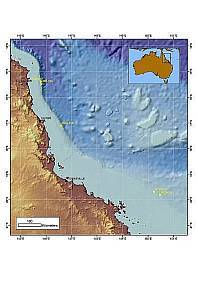|
| |
|
|
IODP Expedition 325
Great Barrier Reef Environmental Changes
 The timing and course of the last deglaciation is considered an essential component for understanding the dynamics of large ice sheets (Lindstrom & MacAyeal, 1993) and their effects on Earth's isostasy (Lambeck, 1993; Peltier, 1994). Moreover, the disappearance of glacial ice sheets was responsible for dramatic changes in the freshwater fluxes to the oceans which disturbed the general thermohaline circulation and hence global climate (e.g. Stocker & Wright, 1991). Coral reefs are excellent sea-level indicators and their accurate dating by mass spectrometry is of prime importance for the determination of the timing of deglaciation events and thus for the understanding of the mechanisms driving the glacial–interglacial cycles. Furthermore, scleractinian coral colonies can monitor sea-surface temperatures (SSTs) as well as other oceanographic parameters (e.g., salinity and sediment run-off) and fossil corals can be used as recorders of past variations in these parameters. This Expedition proposes to core at several offshore sites along transects on the Great Barrier Reef.
- The first objective will be to reconstruct the deglaciation curve for the period 20,000 to 10,000 calendar years before present (cal.yrs BP) in order to establish the minimum sea-level during the Last Glacial Maximum, and to assess the validity, timing and amplitude of meltwater pulses (so-called 19ka MWP, MWP-1A and MWP-1B events; c. 19,000, 13,800 and 11,300 cal. yrs BP) which are thought to have disturbed the general thermohaline oceanic circulation and, hence, global climate.
- Secondly, to establish the sea surface temperature variation accompanying the transgression at each transect. These data will allow us to examine the impact of sea-level changes on reef growth, geometry and biological makeup, especially during reef drowning events, and will help improve the modeling of reef development.
- The third major objective will be to identify and to establish patterns of short-term paleoclimatic changes that are thought to have punctuated the transitional period between present-day climatic conditions following the Last Glacial Maximum. It is proposed to quantify the variations of sea surface temperatures based on high-resolution isotopic and trace element analyses on massive coral colonies. When possible, we will try to identify specific climatic phenomena such as El Nino-Southern Oscillation in the time frame prior to 10,000 cal. yrs BP.
 Expedition 325 Proceedings Expedition 325 Proceedings
|
|
Contact info
|Webmaster
|
| |



|
| |